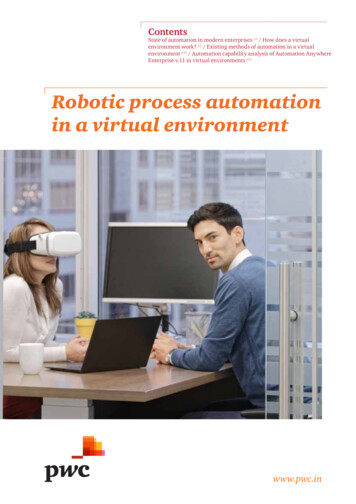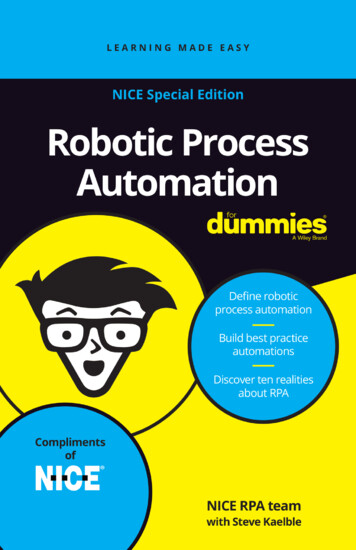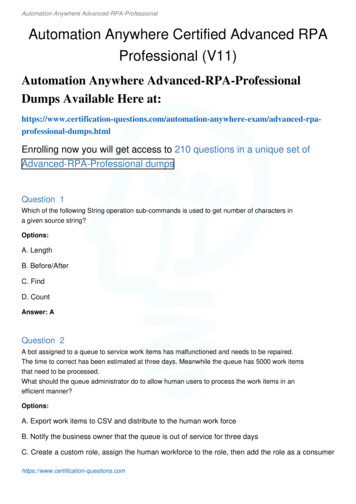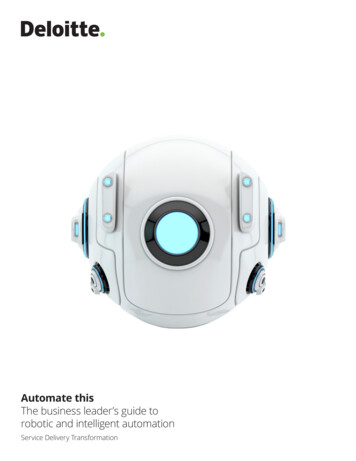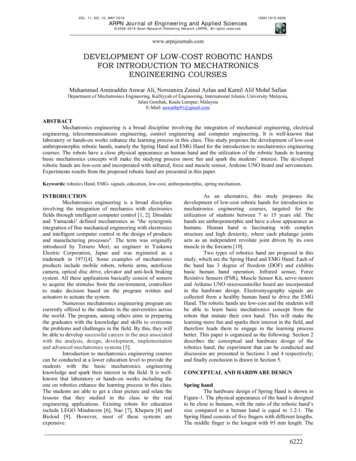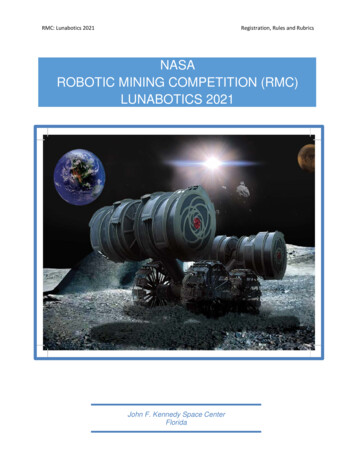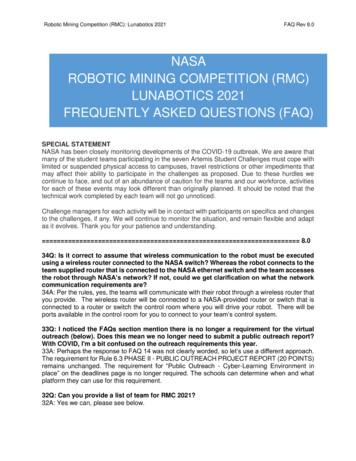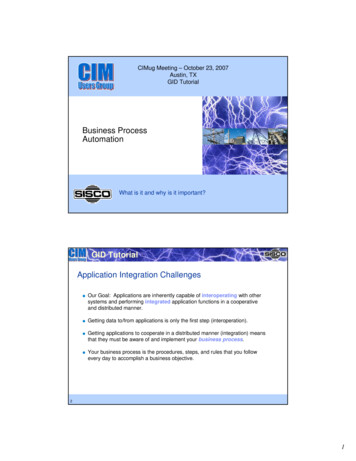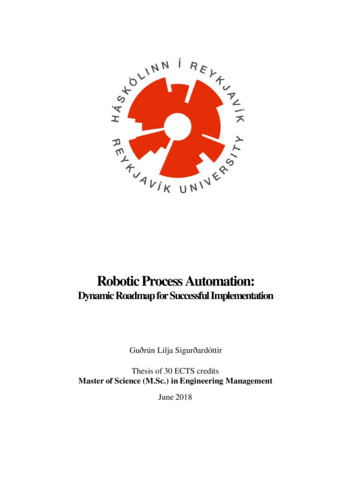
Transcription
Robotic Process Automation:Dynamic Roadmap for Successful ImplementationGuðrún Lilja SigurðardóttirThesis of 30 ECTS creditsMaster of Science (M.Sc.) in Engineering ManagementJune 2018
Robotic Process Automation:Dynamic Roadmap for Successful ImplementationThesis of 30 ECTS credits submitted to the School of Science and Engineeringat Reykjavík University in partial fulfillment ofthe requirements for the degree ofMaster of Science (M.Sc.) in EngineeringManagementJune 2018Supervisors:Dr. Páll Jensson, SupervisorProfessor, Reykjavík University, IcelandDr. Þórður Víkingur Friðgeirsson, SupervisorProfessor, Reykjavík University, IcelandExaminer:Páll Kr. Pálsson, ExaminerAssistant Professor, Reykjavik University, Iceland1
ii
CopyrightGuðrún Lilja SigurðardóttirJune 2018iii
iv
Robotic Process Automation:Dynamic Roadmap for Successful ImplementationGuðrún Lilja SigurðardóttirJune 2018AbstractThe purpose of this MSc thesis seeks to uncover the efficient way of implementingRobotic Process Automation (RPA) successfully. This study aims to giveorganizations insight into how to successfully implement RPA and what factors tobeware of to avoid failure. The main literature that is supporting this research isprevious research of RPA along with a comparison to IT development via BusinessProcess Management. Experts in the field that have experience of implementingRPA were interviewed for this research. The results are present as a dynamicroadmap for RPA implementation with a description of what risk factors it isnecessary to beware of to avoid failure.The results indicate that the value is not only in the robot. When a number ofautomated processes increases then RPA gets more complicated. Organizationsneed to be able to understand RPA and therefore build a structure for RPA withappropriate RPA team. Including change management right from the beginning isfundamental; when the changes are applied, employees have to be prepared forthem. Companies need to continuously work on the process assessment andtherefore identify, optimize and prioritize processes for the RPA lifecycle.Companies that have RPA team with lack of knowledge could experience thatsome part of the RPA lifecycle is not carried out successfully, which can have anadverse effect later on in RPA lifecycle and result as project failure. RPA projectevaluation depends mainly on the objectives of the project and therefore the typeof processes that are automated.Keywords: RPA, software robot, BPM, roadmap, implementation.5
vi
Robotic Process Automation:Dynamic Roadmap for Successful ImplementationGuðrún Lilja Sigurðardóttirjúní 2018ÚtdrátturÍ þessari ritgerð er að leitast við að finna hagkvæma og skilvirka leið viðinnleiðingu á Robotic Process Automation (RPA). Markmið rannsóknarinnar er aðfyrirtæki og stofnanir fái yfirsýn yfir helstu þætti í innleiðingarferli á RPA meðárangursríkum hætti og þá einkum það sem þarf að hafa í huga til að forðast mistök.Rannsóknir sérfræðinga í innleiðingu RPA eru bornar saman við almennatækniþróun á sambærilegu sviði og loks eru viðtöl tekin við sérfræðinga sem starfavið innleiðingu á RPA víðs vegar um heimin.Niðurstöður rannsóknarinnar er svo teknar saman með uppsetningu á sérstökumferli þar sem leitast er við að útlista þau atriði sem eiga að koma í veg fyrir mistökí ferlinu. Af niðurstöðum rannsóknarinnar má draga þá ályktun að innnleiðing áRPA verði flóknari eftir því sem sjálfvirkum ferlum fjölgar. Þá er mikilvægt aðfyrirtæki tileinki sér þá aðferðafræði sem nauðsynleg er fyrir innleiðingarferlið. Íþví felst m.a að sérfræðiþekkingar er þörf á öllum hlutum lífsferils RPA ef vel á aðtakast. Stöðug forgangsröðun, hagræðingar og greiningar á öllum ferlum ásamtinnleiðing á breytingarstjórnun, strax í upphafi er nauðsynlegur grunnur þegarsjálfvirkum ferlum fjölgar. Mat á árangri RPA verkefnis fer eftir upphaflegumarkmiði hverju sinni og þar með tegund þeirra ferla sem á að sjávirknivæðavii
viii
Robotic Process Automation:Dynamic Roadmap for Successful ImplementationGuðrún Lilja SigurðardóttirThesis of 30 ECTS credits submitted to the School of Science and Engineeringat Reykjavík University in partial fulfillment ofthe requirements for the degree ofMaster of Science (M.Sc.) in Engineering ManagementJune 2018Student:Guðrún Lilja SigurðardóttirSupervisors:Dr. Páll JenssonDr. Þórður Víkingur FriðgeirssonExaminer:Páll Kr. Pálsson9
x
The undersigned hereby grants permission to the Reykjavík University Library to reproducesingle copies of this Thesis entitled Robotic Process Automation: dynamic Roadmap forImplementation and to lend or sell such copies for private, scholarly or scientific researchpurposes only.The author reserves all other publication and other rights in association with the copyrightin the Thesis, and except as herein before provided, neither the Thesis nor any substantialportion thereof may be printed or otherwise reproduced in any material form whatsoeverwithout the author’s prior written permission.dateGuðrún Lilja SigurðardóttirMaster of Sciencexi
xii
“It has become appallingly obvious that our technology has exceeded our humanity.”- Albert Einsteinxiii
xiv
AcknowledgmentsThis master’s thesis marks the end of master’s program in engineering management at ReykjavikUniversity. Several people have provided their support during the work with this thesis. Without you,this thesis would not have reached this level.To my supervisors, Páll Jensson and Þórður Víkingur Friðgeirsson, I would like to thank you for yourguidance and support through the creation of this thesis.Then I would like to thank the interviewees for taking their time off for the interviews and support mewith their knowledge.Finally, I would like to thank my family for patience and endless support they have shown me duringthis semester.Guðrún Lilja Sigurðardóttirxv
xvi
ContentsAcknowledgments . xvContents . xviiList of Figures . xixList of Tables . xxiList of Abbreviations . xxiii1 Introduction . 11.1 Background. 21.2 Research questions . 31.3 Assumptions and Limitations . 31.4 Structure of the thesis . 42 Research methodology . 52.1 Literature Review Methodology . 62.2 Data Collection . 62.2.1 Interviews . 62.3 Data analysis . 83 Robotic Process Automation and a comparison to IT development . 93.1 Robotic Process Automation . 93.1.1 RPA classified as lightweight IT . 113.1.2 RPA tools . 123.2 Comparison of RPA and IT development via BPM . 143.2.1 BPM implementation methodology . 153.3 Summary . 164 Previous research of RPA Implementation . 174.1 Company 1: RPA consultant service provider . 174.2 Company 2: Financial Shared Services. 174.3 Company 3: Mobile telecommunication provider . 184.4 Company 4: Energy Sector. 194.5 Company 5: BPO service provider . 204.6 Summary . 215 Dynamic Roadmap for RPA Implementation . 225.1 Phase I . 225.1.1 Process Assessment . 225.1.1.1 Choose wrong processes for RPA . 235.1.1.2 Process assessment not carried out correctly . 24xvii
5.1.2Proof of Concept . 265.1.2.1 Focusing only on technical PoC . 275.1.2.2 Lack of understanding of RPA requirements . 275.1.2.3 Failure to build a successful Business Case . 285.2 Phase II . 305.2.1 Project design and build . 305.2.1.1 RPA without an Operating Model . 305.2.1.2 RPA without Change Management . 315.2.2 RPA Lifecycle . 325.2.2.1 RPA team with lack of knowledge . 325.2.2.2 Underestimate testing in RPA Lifecycle . 345.2.2.3 RPA projects evaluation. 355.3 Summary . 386 Discussion . 426.1 Findings Reliability . 426.2 Building Center of Excellence . 436.3 Re-engineering processes for RPA . 446.4 Further research . 457 Conclusion. 467.1 Summary of research . 468 Bibliography . 49xviii
List of FiguresFigure 1: Research process (Kothari, 2004) . 5Figure 2: The circular process of coding (DeCuir-Gunby et al., 2011) . 8Figure 3: Example of a simple process for RPA (Willcocks & Lacity, 2016). . 9Figure 4: Feature of RPA processes (Sutherland, 2013), (Willcocks & Lacity, 2016). . 10Figure 5: Example of the process that was automated using Blue Prism (Screenshot fromBlue Prism software) . 13Figure 6: Implementation methodology for BPM (Chang, 2006) . 15Figure 7: Company 1 main stages of RPA implementation. 17Figure 8: Company 2 main stages of RPA implementation. 18Figure 9: Company 3 main stages of RPA implementation. 19Figure 10: RPA lifecycle for Company 4 . 20Figure 11: Company 5 main stages of RPA implementation . 20Figure 12: Dynamic Roadmap for RPA implementation . 39xix
xx
List of TablesTable 1: Interviewees identification and their roles in RPA projects . 7Table 2: Heavyweight vs. Lightweight IT (Bygstad, 2017). 11Table 3: Factors that can cause failure when implementing RPA and appropriate references. 41xxi
xxii
List of I:SME:Robotic Process AutomationInternet of ThingsInformation TechnologyArtificial IntelligentFull Time EquivalentProof of ConceptCenter of ExcellentBusiness Process ReengineeringBusiness Process ManagementReturn on investmentSubject Matter Expertxxiii
xxiv
1 IntroductionTechnology is quickly advancing; computers have started listening and speaking, and we haverobots that can handle imprecise tasks that are currently done by humans (Brynjolfsson &McAfee, 2014). Organizations have to respond to increased challenges from customers’ needsand remain competitive by reducing cost. Robotic Process Automation (RPA) enablesorganizations to automate repetitive and tedious tasks and therefore provides a way of reducingoperating costs (Forrester Research, 2014). Organizations that have made use of the RPAtechnology have not only noticed massive savings on full-time equivalent (FTE), they havealso experienced other benefits including improved service, quality and speed, lower error rateand staff satisfaction (Willcocks & Lacity, 2016).According to Lamberton (2016), 30-50% of the first RPA projects within an organization fail.The term RPA is relatively new, however, the market is growing fast. To be able to avoid thecommon mistakes in RPA project failure, it is crucial to define a roadmap for theimplementation.In this research, it is investigated how to successfully implement RPA from the beginning ofthe roadmap, where the business problems are defined, to the end of the entire process whenRPA is part of the organization’s strategy. A dynamic roadmap to successfully implement RPAis presented as well as a description of what risk factors organizations need to be aware of toavoid project failure. The roadmap is adapted from a combination of literature and interviewswith experts in the field.This thesis is structured in the following way: chapter 2 is an overview of researchmethodology. In chapter 3, the main features of RPA and its tools are defined, it is alsoexplained why RPA is classified as lightweight IT while examining the main differencebetween lightweight and heavyweight IT. To get a better understanding of RPA, a comparisonof RPA and IT development via BPM and the methodology for BPM implementation isdescribed. In chapter 4, an overview of previous research of RPA implementation is provided,to give a better understanding of the RPA implementation roadmap. In chapter 5, the dynamicroadmap for RPA implementation is presented. Results and further research are discussed inchapter 6. Finally, the conclusion of this thesis can be found in chapter 7.1
1.1 BackgroundAutomation is a system that functions without direct human interaction. Many automatedsystems have this in common: taking out the most unreliable factor (human error) thusimproving precision, quality, and accuracy. The first idea of how to automate processes usingsoftware came in 1935, when the computer scientist Alan Turing described how a systematicalalgorithm could work processes more effectively. His ideas on algorithms and automation hada lasting impact (Middelburg, 2017).The beginning of the technological development started in 1964 when the first laboratoriesresearching artificial intelligence were opened at MIT, and following, in 1965 the first RoboticsInstitute was opened (Willcocks & Lacity, 2016). Service Automation is believed to be the nextwave of development in automation (Middelburg, 2017). Middleburg (2017) described serviceautomation as a technology that is used to automate services and deliver optimal userexperience, where the primary objective is to automate redundant manual labor. Willcocks &Lacity (2016) define RPA as service automation, but other terms apply to service automation.For example, a scripting tool, artificial intelligence, cognitive computing, BPM, etc. RPAaddresses the part of service automation that automates structured processes (Willcocks &Lacity, 2016). Robotic Process Automation is defined by the IEEE Standards Association as:“A preconfigured software instance that uses business rules and predefined activitychoreography to complete the autonomous execution of a combination of processes,activities,transactions, and tasks in one or more unrelated software systems to deliver a resultor service with human exception management” (IEEE Std 2755-2017, 2017).The term Robotic Process Automation (RPA) was first used in 2012 and was created bymarketing director Patric Geary, who worked for the RPA software company, Blue Prism(Hindle, Lacity, Willcocks, & Khan, 2018). RPA is a newly developed technology and there isno proper research from the early stages of use. RPA began to gain popularity in 2014 and2015 when companies started to announce considerable savings due to automation. The marketfor RPA back-office automation was becoming more significant by early 2016, but it was stillrelatively small-scale during this time (L. Willcocks & Lacity, 2016). According to Horses forSources Research (2017) and Everest Group research (2017), the global RPA market whichincludes both RPA services and RPA software increased by about 64% from 2016 to 2017(from 271 million to 443 million) (Fersht & Snowdan, 2017) (Everest Global, 2017). HfS2
Research (2017) reported a 42% increase in the market from 2017 to 2018 and an expectedincrease around 94% from 2018 to 2021 (Fersht & Snowdan, 2017).1.2 Research questionsTo investigate the dynamic roadmap for successful implementation of RPA and what factorscan cause failure when implementing RPA, the research questions are the following:How to successfully implement a Robotic Process Automation?What is Robotic Process Automation?What factors can cause failure when implementing RPA?What factors are common for RPA project evaluation?The researcher found it interesting to investigate how to implement RPA successfully for manyreasons. First, RPA is relatively new and there is little prior research on RPA implementation.Second, the researcher believes that RPA will have a high impact on
to give a better understanding of the RPA implementation roadmap. In chapter 5, the dynamic roadmap for RPA implementation is presented. Results and further research are discussed in chapter 6. Finally, the conclusion o
